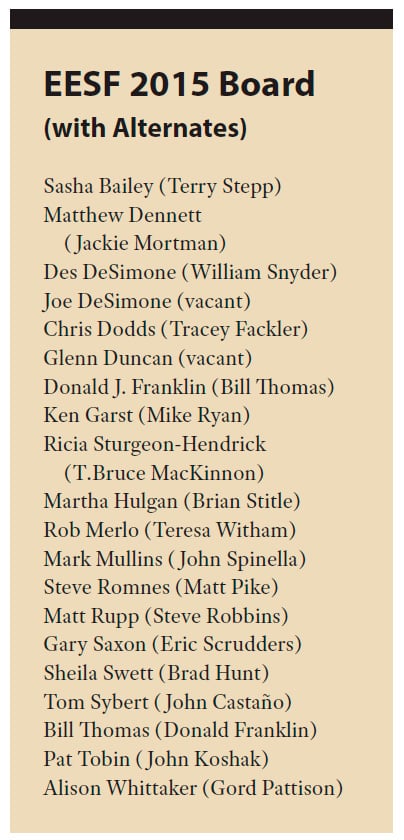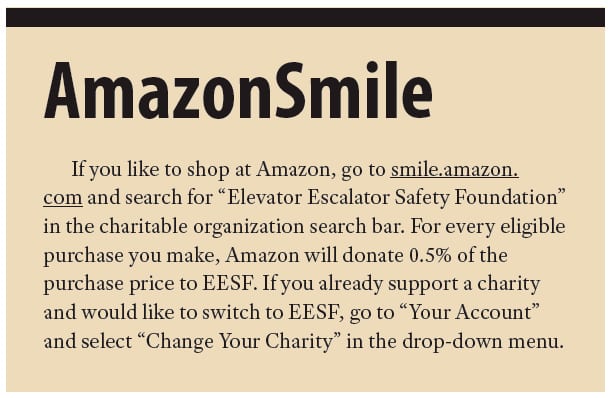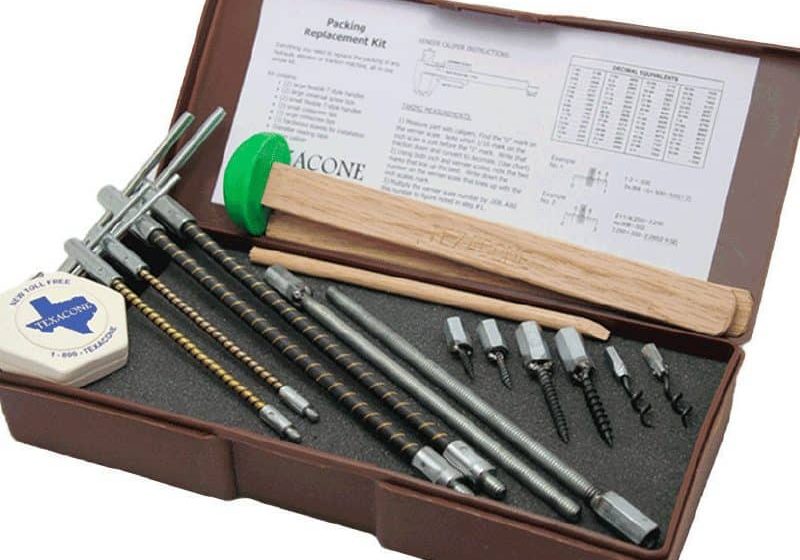EESF Holds AGM Meeting
May 1, 2015

The Elevator Escalator Safety Foundation (EESF) focuses on change at Tampa meeting.
EESF exists to put itself out of business, theoretically speaking. With each child, college student and elderly person educated on the safe use of elevators and escalators, there is an increased benefit to the industry and less of a need for the Foundation. But since there is a long way to go, the industry will continue to rely on the commitment of the EESF board and staff members. These dedicated people met for the foundation’s Annual General Membership (AGM) meeting on March 2-3 at the DoubleTree by Hilton hotel in sunny Tampa, Florida – a far cry from last year’s snowed-in meeting in Atlanta.
“I believe in the mission of EESF. These accidents happen all the time. People don’t realize that escalators and elevators are heavy machinery. I tell parents, ‘You wouldn’t let your kids play on a backhoe, so why would you let them play on an escalator?’ ” – Chris Dodds
Though the organization of events for this year’s AGM meeting proved typical, the topics discussed were anything but. Change in personnel, board members and programs were the main topics of discussion. Members of the Executive Board met on Monday afternoon to debrief and prepare for the upcoming meetings. The new-member orientation session followed that afternoon with a welcome reception in the evening. The AGM meeting took up the bulk of members’ attention the next day.
Planning for Change
EESF Chairman John Koshak led an orientation session for new board members and regents. He opened the New Member Orientation session with a brief history of EESF. Since its inception in 1991, the Foundation has reached more than nine million children with its safety message, and it has expanded to Canada (1994), India (2011) and Australia (2014). A whole generation has now passed through the Foundation’s programs, which have included Safe-T Rider, A Safe Ride® (to educate the elderly), National Elevator Escalator Safety Awareness Week (held the first full week of November every year) and Rise Up Safe Rider (for college-age students).
Now, EESF is in the midst of rebranding its signature Safe-T Rider program for the next generation. The decision to rebrand was not an easy one, according to Koshak, and EESF Treasurer Gary Saxon agreed that it was a financially hard decision to make. Even though the foundation has lowered its expenses over the past few years, its funds are still down a significant amount. They have had to divert energy and resources away from existing programs to focus on rebranding.

In 2013, it was argued that Safe-T Rider was due for a change for a number of reasons. For one, it is hard to promote to school officials and teachers, due to its outdated appearance. It is difficult to calculate the number of teachers who did not use the program for that reason. It was also felt that EESF should be fundraising from the Building Owners and Managers Association, and that it should reduce costs and increase its social-media presence and consumption of its products.
Since that time, the rebranding committee has worked hard to come up with an alternative. Tom Sybert gave a presentation on recent developments on the rebranding of the program. The Rebranding Committee had found an advertising agency that came up with three different characters, each with their own storylines and songs. The agency is approaching the project with the goal to entertain first and educate second, and it is seeking to focus not only on schools and public spaces, but also on creativity in reaching out to parents and developing activities for a generation that knows how to use a tablet before they are even two years old. (For proof, search YouTube for “A Magazine Is an iPad That Does Not Work.”)
Sybert presented the character and storyline of each concept, though he did not sing the songs for the board, unfortunately. The board liked elements from each concept. They made it clear that the rebranded program not have any similarities to the old character, song and story. That meant “no rap,” to the disappointment of some. One of the characters was a superhero with a cape. Matt Pike pointed out that it would not be a good idea for the character teaching children about safety to be wearing a cape on an escalator. For that comment, he was immediately volunteered to join the rebranding committee. The board concluded the discussion by tasking the committee to submit its recommendations to the agency to create one safety presentation that incorporates the approved elements.
The board also discussed additional rules and safety tips due to recent accidents involving handrails and swing doors in residential elevators. Pat Tobin reminded the board to keep the wording of the rules positive. Any rule telling children not to do something would only galvanize bad behavior, or, even worse, give them ideas. Dealing with the space between the swing door and gate in a residential elevator is especially difficult. As Sheila Swett said, “How do you address a space if it is not supposed to exist?”
The rebranding process, though, will not end here. Newly appointed Executive Director Nikole Gore-Layton said the Foundation would “plan for change.” The next character will not have to wait 20 years before it can retire.
Fundraising and the Foundation
As expected, there was a lively discussion about the Foundation’s finances. Glenn Duncan proposed that the fundraising efforts not be split between the Foundation and rebranding project, but that everything go into one fund with a cap on the amount that would go to rebranding. A motion on this was made and passed. In addition, the Foundation’s emergency fund will be rebuilt now that its debt has been paid off.
Like any nonprofit organization, EESF’s effectiveness does rise and fall on the outcome of its fundraising initiatives. Since the 1990s, the Foundation’s funds have risen steadily, with dips in 2004 and 2008. Organizations like EESF are always the first to feel a recession and the last to benefit from a recovery. The founding members funded EESF for many years, and some continue to do so, but the industry has slowly replaced the funding that has since been lost. Various funding avenues have been explored and pursued, including AmazonSmile.
Rob Merlo and Teresa Witham gave a report from the National Association of Elevator Contractors (NAEC). It was also mentioned that Gore-Layton is scheduled to make a presentation on behalf of EESF at the NAEC Spring Conference in April, where she would talk about the workplace campaign before the entire gathering. Representing NAESA International, Bill Snyder noted that he discerned a better, more focused attitude at this year’s AGM meeting: “For the past couple of years, the organization has been wandering.” EESF of Canada representatives Alison Whitaker and Gord Pattison reported they are excited about the rebranding process. Ricia Sturgeon-Hendrick reported Elevator World, Inc. would continue to support the foundation in various ways, including its participation in the workplace giving campaign.
In his Personnel Committee report, Saxon said the organizational structure of EESF had been reduced, and new members were nominated and approved to join the executive board and board of regents. Koshak stepped down from his position as EESF chair. He said he enjoyed his tenure but lamented, “My only regret is that things did not move faster.” He hopes that starting with the EESF board, there would be more buy-in from the industry in the future.
Mountains to Climb
The mission of the Foundation can be a hard sell at times. On one hand, continued accidents and fatalities provide a clear mandate for the organization to continue to spread the word about safety, but, at the same time, it can’t overplay its hand by showing just how serious accidents can be, because it would be off-putting to passengers and offensive to companies that support them.
Elevator manufacturers are uneasy with this issue. Sturgeon-Hendrick pointed out that companies have said, in so many words, “Don’t ever say that our machines are dangerous pieces of equipment.” Retailers are not that open to promoting safety, either: “Owners of malls want nothing to do with it. They don’t want to instill fear in customers by drawing attention to the danger of escalators,” noted Pattison. They would rather deal with the aftermath of accidents than seek to prevent them, as Chris Dodds argued:
“Stores and their lawyers are so efficient at cleaning up and keeping an accident quiet as if nothing had happened. We know it happens all the time, but the public doesn’t. A representative from an OEM made an eye-opening comment at a previous meeting when he said that his company would only keep pace with what the other majors donated, because it would look like an admission of guilt if they gave more.”
The members of the EESF board are committed to promoting safety despite the obstacles they face from their colleagues, the industry or the public. At the same time, Martha Hulgan challenged the board members to regain a sense of passion and mission: “How many of us have actually watched videos of kids being pulled out of escalators with missing toes? … This could be your grandchild.”
Even though two jobs take up much of his time, Dodds says he volunteers on the EESF board, because:
“I believe in the mission of EESF. These accidents happen all the time. People don’t realize that escalators and elevators are heavy machinery. I tell parents, ‘You wouldn’t let your kids play on a backhoe, so why would you let them play on an escalator?’”
Minimizing the dangers does have consequences. Cornelius Walls noted, “We decided we’d never show the gore. So, we’ll never get as popular as Mothers Against Drunk Driving, which put up mangled cars in public.” So, EESF is stuck between a rock and a hard place. There are serious dangers we need to prevent, but at the same time, as Duncan cautioned the group, “Let’s keep this in perspective; we’re still the safest industry.”
Aside from the challenges, being a nonprofit organization that relies on funding does have some advantages. For one, as a third party, EESF can persuade jurisdictions that don’t follow standard codes to adopt a safety program. As a representative of a major company, Pike notes, “If we talk to them, they think we’re trying to sell them something.” This is a valuable service EESF provides to the industry.
At the end of the day, the tone of the meeting was positive. Swett remarked with a smile, “I’m walking away from this meeting optimistic, and I’m glad about it!”

Get more of Elevator World. Sign up for our free e-newsletter.









